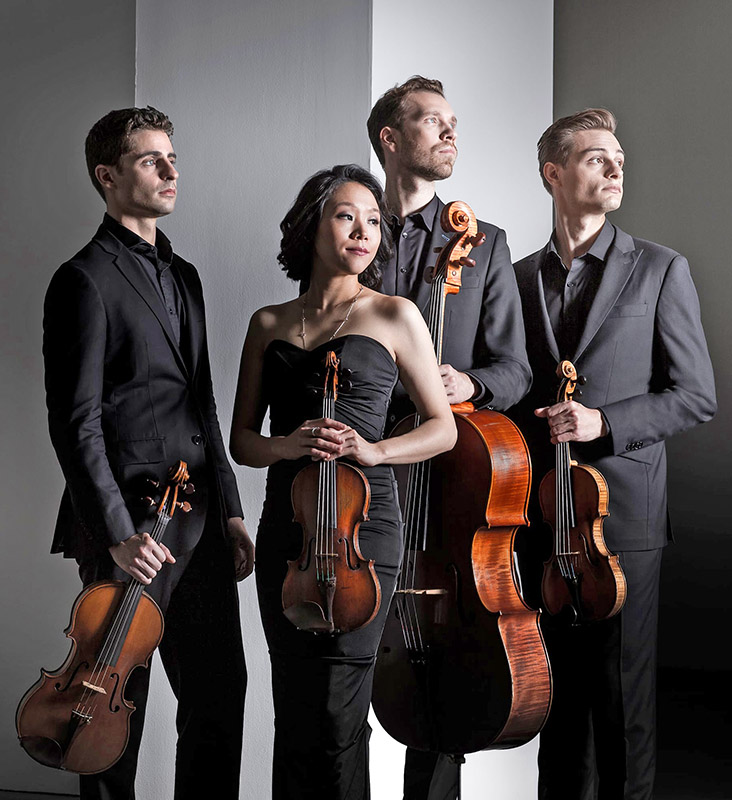
 Formed by Juilliard students in 2008, and active ever since, the wonderful Tesla Quartet finally made its Maverick Concerts yesterday, 13 years later. Management should waste no time reengaging them.
Formed by Juilliard students in 2008, and active ever since, the wonderful Tesla Quartet finally made its Maverick Concerts yesterday, 13 years later. Management should waste no time reengaging them.
Some string quartets pursue a conversation among four musicians, while others seek a 16-string unity. The Tesla Quartet launched into Haydn’s Quartet in C Major, Op. 76, No, 3, the “Emperor,” making it immediately apparent that the Tesla seeks unity and achieves it supremely well. Balances came across with virtually perfection, and the folk-dance segment in the first movement’s development sounded appropriately raunchy. What’s more, we got to hear it twice, since the players gave us both the exposition and the development/recapitulation repeats in that movement, something one almost never get to hear. First violinist Ross Snyder explained after the concert, “There’s more material in there. We have to play it.” I agree, but most quartets don’t.
Caroline Shaw’s Plan and Elevation: The Grounds of Dumbarton musically describes the famous estate for which Stravinsky wrote his Dumbarton Oaks Concerto. Shaw is an interesting composer and a Pulitzer Prize winner, but this example ranged from engrossing to bland. Shaw’s sneaky quotes from Beethoven and Debussy evinced a lively musical cleverness. There’s a lot of pizzicato in her Dumbarton, including some attractively weird effects; those passages displayed the awesome precision of the group.
There was also a lot of uncannily tight ensemble work in Schubert’s String Quartet in G Major, D. 887, his final one. But that wasn’t the most noteworthy aspect of the memorable interpretation. This foursome has thoroughly integrated the remarkable innovations of Schubert’s writing, the rapid changes of emotion back and forth, the lengthy developments of lengthy ideas, the way terror sometimes lurks behind pleasantness. I really liked the tempo of the second movement, just a little faster than usual, not enough to feel rushed but enough to honor the “moto” in Schubert’s indication “Andante un poco moto.” The wide range of dynamics in the finale helped convey the impact of the music, and their subtle acceleration intensified the emotions.

Pianist Adam Tendler returned to the Maverick with substantial postlude. Although the string quartet portion was quite lengthy, most of the audience remained. Tendler has shown himself before at Maverick, as a contemporary music specialist, but he opened this time with a lovely, sensitive version of Schubert’s Allegretto in C Minor, D. 915, including all of its repeats.
Without pause, Tendler then launched into Julius Eastman’s Piano 2. This Black composer died a tragic figure in 1990, many of his scores lost, but recently he has been subject to a wide-ranging revival and re-evaluation. From listening to some Eastman on YouTube I can understand what at least some of the fuss is about. Piano 2 came off like a somewhat episodic improvisation, sometimes fascinating, sometimes just filler. Tendler’s subtle shaping made the best possible case for it..
To conclude his mini-recital, Tendler took on one of the great challenges of the piano repertoire, Stravinsky’s Three Movements from Petrushka, written for Artur Rubinstein. (A live performance by Rubinstein has recently shown up on the internet.) For years, Alexis Weissenberg’s recording set the standard; I heard him duplicate that achievement in concert. From a remark of Tendler’s, it seems he may be new to this work. He played with excellent musical comprehension, but he resorted to relatively slow tempos and tricks like giving himself an extra beat to make difficult leaps. The audience ate it up, but I’m burdened by having heard better takes. I hope Tendler’s repetitious, boring encore wasn’t written by anyone I like. Philip Glass maybe?
Leslie Gerber, who lives in Woodstock, New York, has been reviewing professionally since 1966, for such venues as Performance Today, Fanfare, and Amazon.com. He also publishes the Parnassus Records label.


